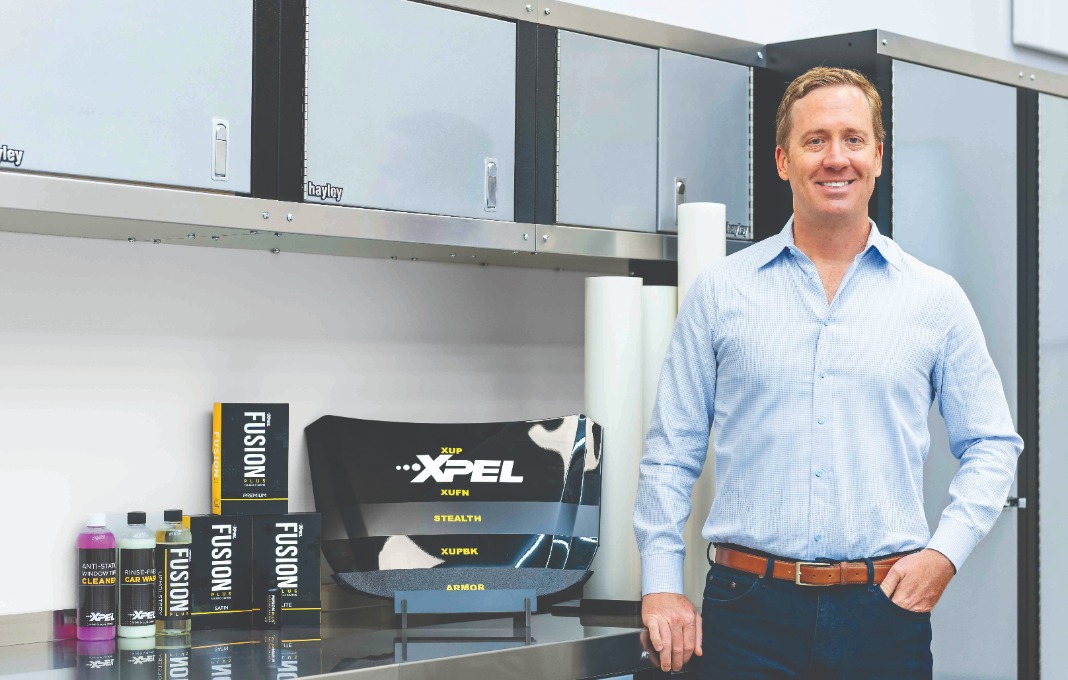Xpel Balances Customer Responsiveness With Manufacturing Scale


Ryan Pape is pondering a major decision for his company, Xpel, which makes protective films and coatings for consumer vehicle and architectural markets. And it’s a common one for manufacturing CEOs: To make or not to make.
The commonality of his dilemma doesn’t make the decision-making process any easier for Pape, whose company is benefiting from continued penetration in existing markets for coating car and boat painted surfaces and windows, as well as architectural windows, and is expanding its footprint with American consumers, but is being hampered to an extent by the slowing of the economy.
Xpel for years has been focused on expanding and improving its sales and marketing operations and on bolstering its popular aftermarket brands with car and marine enthusiasts, and leveraging this network into new verticals such as residential and commercial window coverings. But Pape is investigating a major pivot for Xpel that involves manufacturing.
“When you’re making an optical product, quality is No. 1,” the president and CEO of the San Antonio-based company tells Chief Executive. “You’re not going to accept any defects on the hood of your new car. It was an early decision for us to either put all of our time and effort into scaling manufacturing, or into building the channel, and we took the route to put all our efforts into the channel. We are forward-deployed closer to customers” such as auto dealers and aftermarket vehicle-services companies, including many independent operations.
Among Xpel’s promises to its retail dealers is “to keep our inventories close to those customers and get them out. There’s not a lot of margin for error. We want to serve those customers well.
“It’s been important for us to help paint-protective film get to critical mass, and I don’t know if that would have happened if we had concentrated on the other side of the equation” by emphasizing Xpel’s own manufacturing.
To get to this point, Pape explains, the $400-million company has been taking advantage of the fact that roll-to-roll converting capacity by coating manufacturers is more available around the world than ever, given how traditional photographic film has dwindled as a market faster than makers could slash capacity. Xpel uses multiple companies to contract out the manufacturing of its products. Its competitors include Eastman Chemical and 3M.
“But as we scale, our own economies are shifting,” Pape explains, “so internalizing that manufacturing is something that’s out there for us, and something we continue to evaluate on a rolling basis.”
Among the factors Pape has been considering is “assuring we have the volumes to justify any manufacturing expansion and that we’ve got the team internally to manage multiple new products at once.”
That priority may seem to be questionable given that Xpel’s first-quarter revenue increased only by 5 percent compared with a year earlier, while net income plunged by 42 percent. But that performance followed a full-year increase in revenues of 22 percent and a 28 percent boost in profits in 2023. And Pape told investors in May that, after some first-quarter challenges, “we did see some momentum return in our April numbers, and we are optimistic that momentum will continue as we progress throughout the year.”
Second, as he considers self-manufacturing, Pape is weighing Xpel’s “ability to focus. We have a very high-touch service model,” he says. “We go deep with [retailer] customers and provide a lot of value, so in many respects, selling the idea of being an Xpel dealer in the automotive aftermarket is not a widget business. We don’t want to distract from that focus.”


0

1:00 - 5:00 pm
Over 70% of Executives Surveyed Agree: Many Strategic Planning Efforts Lack Systematic Approach Tips for Enhancing Your Strategic Planning Process
Executives expressed frustration with their current strategic planning process. Issues include:
Steve Rutan and Denise Harrison have put together an afternoon workshop that will provide the tools you need to address these concerns. They have worked with hundreds of executives to develop a systematic approach that will enable your team to make better decisions during strategic planning. Steve and Denise will walk you through exercises for prioritizing your lists and steps that will reset and reinvigorate your process. This will be a hands-on workshop that will enable you to think about your business as you use the tools that are being presented. If you are ready for a Strategic Planning tune-up, select this workshop in your registration form. The additional fee of $695 will be added to your total.

2:00 - 5:00 pm
Female leaders face the same issues all leaders do, but they often face additional challenges too. In this peer session, we will facilitate a discussion of best practices and how to overcome common barriers to help women leaders be more effective within and outside their organizations.
Limited space available.

10:30 - 5:00 pm
General’s Retreat at Hermitage Golf Course
Sponsored by UBS
General’s Retreat, built in 1986 with architect Gary Roger Baird, has been voted the “Best Golf Course in Nashville” and is a “must play” when visiting the Nashville, Tennessee area. With the beautiful setting along the Cumberland River, golfers of all capabilities will thoroughly enjoy the golf, scenery and hospitality.
The golf outing fee includes transportation to and from the hotel, greens/cart fees, use of practice facilities, and boxed lunch. The bus will leave the hotel at 10:30 am for a noon shotgun start and return to the hotel after the cocktail reception following the completion of the round.